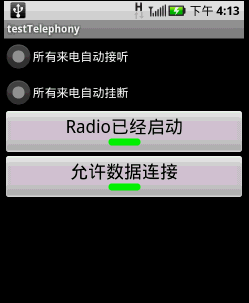
- WindowManagerService服务是如何以堆栈的形式来组织窗口
- Android 退出程序的若干方法总结
- Android使用post方式上传图片到服务器的方法
- 仅5步搞定Android开发环境部署 Android开发环境搭建教程
- Android多功能时钟开发案例(基础篇)
- Android 操作系统获取Root权限 原理详细解析
- ERROR/AndroidRuntime(17121)的问题解决
- android4.0混淆XmlPullParser报错原因分析解决
- Android-如何将RGB彩色图转换为灰度图方法介绍
- android从资源文件中读取文件流并显示的方法
- Android 再按一次返回键退出程序实现思路
- [Android开发视频教程]02_03_常见控件(六)
- android读取短信示例分享
- Android中的脑残设计总结
- Android中使用SQLite3 命令行查看内嵌数据库的方法
- Android编程绘制圆形图片的方法
- Android实现Banner界面广告图片循环轮播(包括实现手动滑动循环)
- listview改变选中行的字体颜色实例介绍
- android 退出程序解决内存释放的问题
- Android序列化XML数据
- android实现在横竖屏切换时页面信息不被重置的示例分享
- Android图片加载缓存框架Glide
- Android实现zip文件压缩及解压缩的方法
- Android执行shell命令详解
- android读写sd卡操作写入数据读取数据示例
- Android开发:TextView加入滚动条示例
- Andriod arcgis保存Mapview为图片的实例代码
- Android学习之Intent中显示意图和隐式意图的用法实例分析
- android短信拦截的实现代码
- 非常简单的Android打开和保存对话框功能
Android提高之TelephonyManager功能探秘
作者:佚名 Android开发编辑:admin 更新时间:2022-07-23
前面文章介绍了如何使用JAVA的反射机制来调用蓝牙的隐藏API,本文继续来练习JAVA的反射机制,探秘TelephonyManager在Framework里包含却在SDK隐藏的几项功能。
先来看一下本文程序运行的效果图,如下所示:

本文程序演示了以下功能:
1.所有来电自动接听;
2.所有来电自动挂断;
3.开启/关闭Radio;
4.开启/关闭数据连接(WAP or NET的连接)。
调用TelephonyManager的隐藏API是先参考Framework的/base/telephony/java/com/android/internal/telephony/ITelephony.aidl,然后自己实现一个ITelephony.aidl,最后在TelephonyManager中通过反射机制实例化自定义的ITelephony,实例化之后就可以调用ITelephony里面的函数了。
本文程序需要在AndroidManifest.xml添加以下两行代码,以获得权限:
<uses-permission android:name="android.permission.CALL_PHONE" /> <uses-permission android:name="android.permission.MODIFY_PHONE_STATE" />
main.xml源码如下:
<?xml version="1.0" encoding="utf-8"?> <LinearLayout xmlns:android="http://schemas.android.com/apk/res/android" android:orientation="vertical" android:layout_width="fill_parent" android:layout_height="fill_parent"> <RadioGroup android:layout_height="wrap_content" android:layout_width="fill_parent" android:id="@+id/rGrpSelect"> <RadioButton android:layout_height="wrap_content" android:layout_width="fill_parent" android:id="@+id/rbtnAutoAccept" android:text="所有来电自动接听"></RadioButton> <RadioButton android:layout_height="wrap_content" android:layout_width="fill_parent" android:id="@+id/rbtnAutoReject" android:text="所有来电自动挂断"></RadioButton> </RadioGroup> <ToggleButton android:layout_height="wrap_content" android:layout_width="fill_parent" android:id="@+id/tbtnRadioSwitch" android:textOn="Radio已经启动" android:textOff="Radio已经关闭" android:textSize="24dip" android:textStyle="normal"></ToggleButton> <ToggleButton android:layout_height="wrap_content" android:layout_width="fill_parent" android:id="@+id/tbtnDataConn" android:textSize="24dip" android:textStyle="normal" android:textOn="允许数据连接" android:textOff="禁止数据连接"></ToggleButton> </LinearLayout>
PhoneUtils.java是手机功能类,从TelephonyManager中实例化ITelephony并返回,源码如下:
package com.testTelephony;
import java.lang.reflect.Field;
import java.lang.reflect.Method;
import com.android.internal.telephony.ITelephony;
import android.telephony.TelephonyManager;
import android.util.Log;
public class PhoneUtils {
/**
* 从TelephonyManager中实例化ITelephony,并返回
*/
static public ITelephony getITelephony(TelephonyManager telMgr) throws Exception {
Method getITelephonyMethod = telMgr.getClass().getDeclaredMethod("getITelephony");
getITelephonyMethod.setAccessible(true);//私有化函数也能使用
return (ITelephony)getITelephonyMethod.invoke(telMgr);
}
static public void printAllInform(Class clsShow) {
try {
// 取得所有方法
Method[] hideMethod = clsShow.getDeclaredMethods();
int i = 0;
for (; i < hideMethod.length; i++) {
Log.e("method name", hideMethod[i].getName());
}
// 取得所有常量
Field[] allFields = clsShow.getFields();
for (i = 0; i < allFields.length; i++) {
Log.e("Field name", allFields[i].getName());
}
} catch (SecurityException e) {
// throw new RuntimeException(e.getMessage());
e.printStackTrace();
} catch (IllegalArgumentException e) {
// throw new RuntimeException(e.getMessage());
e.printStackTrace();
} catch (Exception e) {
// TODO Auto-generated catch block
e.printStackTrace();
}
}
}
testTelephony.java是主类,使用PhoneStateListener监听通话状态,以及实现上述4种电话控制功能,源码如下:
package com.testTelephony;
import android.app.Activity;
import android.os.Bundle;
import android.telephony.PhoneStateListener;
import android.telephony.TelephonyManager;
import android.util.Log;
import android.view.View;
import android.widget.RadioGroup;
import android.widget.ToggleButton;
public class testTelephony extends Activity {
/** Called when the activity is first created. */
RadioGroup rg;//来电操作单选框
ToggleButton tbtnRadioSwitch;//Radio开关
ToggleButton tbtnDataConn;//数据连接的开关
TelephonyManager telMgr;
CallStateListener stateListner;
int checkedId=0;
@Override
public void onCreate(Bundle savedInstanceState) {
super.onCreate(savedInstanceState);
setContentView(R.layout.main);
telMgr= (TelephonyManager)getSystemService(TELEPHONY_SERVICE);
telMgr.listen(new CallStateListener(), CallStateListener.LISTEN_CALL_STATE);
PhoneUtils.printAllInform(TelephonyManager.class);
rg = (RadioGroup)findViewById(R.id.rGrpSelect);
rg.setOnCheckedChangeListener(new CheckEvent());
tbtnRadioSwitch=(ToggleButton)this.findViewById(R.id.tbtnRadioSwitch);
tbtnRadioSwitch.setOnClickListener(new ClickEvent());
try {
tbtnRadioSwitch.setChecked(PhoneUtils.getITelephony(telMgr).isRadioOn());
} catch (Exception e) {
Log.e("error",e.getMessage());
}
tbtnDataConn=(ToggleButton)this.findViewById(R.id.tbtnDataConn);
tbtnDataConn.setOnClickListener(new ClickEvent());
try {
tbtnDataConn.setChecked(PhoneUtils.getITelephony(telMgr).isDataConnectivityPossible());
} catch (Exception e) {
Log.e("error",e.getMessage());
}
}
/**
* 来电时的操作
* @author GV
*
*/
public class CheckEvent implements RadioGroup.OnCheckedChangeListener{
@Override
public void onCheckedChanged(RadioGroup group, int checkedId) {
testTelephony.this.checkedId=checkedId;
}
}
/**
* Radio和数据连接的开关
* @author GV
*
*/
public class ClickEvent implements View.OnClickListener{
@Override
public void onClick(View v) {
if (v == tbtnRadioSwitch) {
try {
PhoneUtils.getITelephony(telMgr).setRadio(tbtnRadioSwitch.isChecked());
} catch (Exception e) {
Log.e("error", e.getMessage());
}
}
else if(v==tbtnDataConn){
try {
if(tbtnDataConn.isChecked())
PhoneUtils.getITelephony(telMgr).enableDataConnectivity();
else if(!tbtnDataConn.isChecked())
PhoneUtils.getITelephony(telMgr).disableDataConnectivity();
} catch (Exception e) {
Log.e("error", e.getMessage());
}
}
}
}
/**
* 监视电话状态
* @author GV
*
*/
public class CallStateListener extends PhoneStateListener {
@Override
public void onCallStateChanged(int state, String incomingNumber) {
if(state==TelephonyManager.CALL_STATE_IDLE)//挂断
{
Log.e("IDLE",incomingNumber);
}
else if(state==TelephonyManager.CALL_STATE_OFFHOOK)//接听
{
Log.e("OFFHOOK",incomingNumber);
}
else if(state==TelephonyManager.CALL_STATE_RINGING)//来电
{
if(testTelephony.this.checkedId==R.id.rbtnAutoAccept)
{
try {
//需要<uses-permission android:name="android.permission.MODIFY_PHONE_STATE" />
PhoneUtils.getITelephony(telMgr).silenceRinger();//静铃
PhoneUtils.getITelephony(telMgr).answerRingingCall();//自动接听
} catch (Exception e) {
Log.e("error",e.getMessage());
}
}
else if(testTelephony.this.checkedId==R.id.rbtnAutoReject)
{
try {
PhoneUtils.getITelephony(telMgr).endCall();//挂断
PhoneUtils.getITelephony(telMgr).cancelMissedCallsNotification();//取消未接显示
} catch (Exception e) {
Log.e("error",e.getMessage());
}
}
}
super.onCallStateChanged(state, incomingNumber);
}
}
}
感兴趣的读者可以测试一下本文实例代码,希望能够对大家的Android项目开发有所帮助。
- 上一篇文章: Android提高之ListView实现自适应表格的方法
- 下一篇文章: Android提高之蓝牙隐藏API探秘
- 适用于Android开发的简单聊天软件
- Android中的Service相关全面总结
- android中暂停背景音乐
- Android 2.3.7.r1 camera录像过程中按menu菜
- Android控件之AnalogClock与DigitalClock用
- Android定时器和Handler用法实例分析
- Android仿微信语音聊天功能